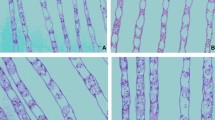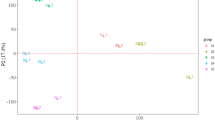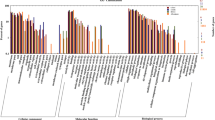Abstract
The swimming crab, Portunus trituberculatus, is an important marine fishery and aquaculture species. Although P. trituberculatus is a euryhaline species, water salinity condition influenced its distribution, migration route, and artificial propagations. To investigate gene expression in the P. trituberculatus exposed to different salinity stresses, 2426 expressed sequence tags (ESTs) from gill cDNA library were selected to spot on a cDNA microarray chip. In total, 417 differentially expressed genes were identified and grouped into eight clusters by hierarchical clustering analysis. Approximately 71.5% of grouped genes belonged to three independent expression patterns, indicating that these three expression patterns may represent three important stress tolerance pathways or networks in P. trituberculatus. Moreover, our cDNA microarray data suggested that there were differences in gene expression patterns of P. trituberculatus for low salinity and high salinity acclimation, suggesting that two salinity challenges resulted in a wide variation of gene expression in P. trituberculatus. In addition, a series of genes such as CCAAT/enhancer-binding protein, Na/K ATPase β-subunit, and heat shock proteins (HSPs) genes were suggested to be key elements during salinity acclimation process. Overall, this work represented an important step toward understanding the molecular processes and mechanisms involved in salinity acclimation of the swimming crab.




Similar content being viewed by others
References
Alejandra C, Rogerio RS, Teresa G, Jorge H, Alma BP, Adriana M, Gloria Y (2007) Transcriptome analysis of gills from the white shrimp Litopenaeus vannamei infected with White Spot Syndrome Virus. Fish Shellfish Immunol 23:459–472
Assinder SJ, Stanton JL, Prasad PD (2009) Transgelin: an actin-binding protein and tumour suppressor. Int J Biochem Cell B 41:482–486
Chang ES (2005) Stressed-out lobsters: crustacean hyperglycemic hormone and stress proteins. Integr Comp Biol 45:43–50
Cimino EJ, Owens L, Bromage E, Anderson TA (2002) A newly developed ELISA showing the effect of environmental stress on levels of hsp86 in Cherax quadricarinatus and Penaeus monodon. Comp Biochem Physiol A Mol Integr Physiol 132:591–598
Coblentz FE, Towle DW, Shafer TH (2006) Expressed sequence tags from normalized cDNA libraries prepared from gill and hypodermal tissues of the blue crab, Callinectes sapidus. Comp Biochem Physiol D 1:200–208
Currie RA, Bombail V, Oliver JD, Moore DJ, Lim FL, Gwilliam V, Kimber I, Chipman K, Moggs JG, Orphanides G (2005) Gene Ontology mapping as an unbiased method for identifying molecular pathways and processes affected by toxicant exposure: application to acute effects caused by the rodent non-genotoxic carcinogen diethylhexylphthalate. Toxicol Sci 86:453–469
Dai AY (1977) Primary investigation on the fishery biology of the Portunus trituberculatus. Mar Fish 25:136–141 (in Chinese)
Dai AY, Yang SL, Song YZ (1986) Marine crabs in China Sea. Marine publishing company, Beijing, pp 194–196 (in Chinese)
de Hoon MJ, Imoto S, Nolan J, Miyano S (2004) Open source clustering software. Bioinformatics 20:1453–1454
Durica DS, Kupfer D, So S, Li H, Wu X, Hopkins PM, Roe B (2003) An EST database of mRNAs expressed during crustacean limb regeneration. Integrat Comp Biol 43:944 (abstract)
Eisen MB, Spellman PT, Brown PO, Botstein D (1998) Cluster analysis and display of genome-wide expression patterns. Proc Natl Acad Sci USA 95:14863–14868
Feder ME, Hofmann GE (1999) Heat-shock proteins, molecular chaperones, and the stress response: evolutionary and ecological physiology. Annu Rev Physiol 61:243–282
Genovese G, Luchetti CG, Luquet CM (2004) Na+/K+ATPase activity and gill ultrastructure in the hyper–hypo-regulating crab Chasmagnathus granulatus acclimated to dilute, normal, and concentrated seawater. Mar Biol 144:111–118
Greene MP, Hamilton MG, Botton ML (2011) Physiological responses of horseshoe crab (Limulus polyphemus) embryos to osmotic stress and a possible role for stress proteins (HSPs). Mar Biol. doi:10.1007/s00227-011-1682-y
Gueguen Y, Cadoret JP, Flament D, Barreau-Roumiguieŕe C, Girardot AL, Garnier J, Hoareau A, Bachère E, Escoubas JM (2003) Immune gene discovery by expressed sequence tags generated from hemocytes of the bacteria-challenged oyster, Crassostrea gigas. Gene 303:139–145
Henry RP, Garrelts EE, McCarty MM, Towle DW (2002) Differential time course of induction for branchial carbonic anhydrase and Na/K ATPase activity in the euryhaline crab, Carcinus maenas, during low salinity acclimation. J Exp Zool 292:595–603
Iwama GK, Vijayan MM, Forsyth R, Ackerman P (1999) Heat shock proteins and physiological stress in fish. Am Zool 39:901–909
Jayasundara N, Towle DW, Weihrauch D, Spanings-Pierrot C (2007) Gill-specific transcriptional regulation of Na+/K+ATPase -subunit in the euryhaline shore crab Pachygrapsus marmoratus: sequence variants and promoter structure. J Exp Biol 210:2070–2081
Ji DS (2005) Techniques of Pond-farming of swimming crab, Portunus trituberculatus. Spe Econo Ani Plant 3:12–13 (in Chinese)
Jillette N, Cammack L, Lowenstein M, Henry RP (2011) Down-regulation of activity and expression of three transport-related proteins in the gills of the euryhaline green crab, Carcinus maenas, in response to high salinity acclimation. Comp Biochem Physiol Part A 158:189–193
Ju Z, Wells MC, Walter RB (2007) DNA microarray technology in toxicogenomics of aquatic models: methods and applications. Comp Biochem Physiol Part C Toxicol Pharmacol 145:5–14
Kong X, Wang G, Li S (2008) Seasonal variations of ATPase activity and antioxidant defenses in gills of the mud crab Scylla serrata (Crustacea, Decapoda). Mar Biol 154:269–276
Li T, Brouwer M (2009) Gene expression profile of grass shrimp Palaemonetes pugio exposed to chronic hypoxia. Comp Biochem Physiol Part D 4:196–208
Lucu Č, Towle DW (2003) Na+/K+ATPase in gills of aquatic crustacea. Comp Biochem Physiol A 135:195–214
Luquet CM, Weihrauch D, Senek M, Towle DW (2005) Induction of branchial ion transporter mRNA expression during acclimation to salinity change in the euryhaline crab Chasmagnathus granulatus. J Exp Biol 208:3627–3636
Nadler ST, Attie AD (2001) Please pass the chips: genomic insights into obesity and diabetes. J Nutr 131:2078–2081
Narayanan V, Barbosa E, Reed R, Gihan Tennekoon G (1988) Characterization of a cloned cDNA encoding rabbit Myelin P2 protein. J Biol Chem 263:8332–8337
Nutricati E, Miceli A, Blando F, De Bellis L (2006) Characterization of two Arabidopsis thaliana glutathione S-transferases. Plant Cell Rep 25:997–1005
Schleich CE, Goldemberg LA, Mananes AAL (2001) Salinity dependent Na+-K(+) ATPase activity in gills of the euryhaline crab Chasmagnathus granulata. Gen Physiol Biophys 20:255–266
Shen JR, Liu RY (1965) Shrimps and crabs in China. Science Popularization Press, Beijing, p 23
Song HT, Ding YP, Xu YJ (1989) Population component characteristics and migration distribution of the Portunus trituberculatus in the coast water of Zhejiang Province. Mar Sci Bull 8:66–74 (in Chinese)
Stepanyan R, Day K, Urban J, Hardin DL, Shetty RS, Derby CD, Ache BW, McClintock TS (2006) Gene expression and specificity in the mature zone of the lobster olfactory organ. Physiol Genomics 25:224–233
Stillman JH, Teranishi KS, Tagmount A, Lindquist EA, Brokstein PB (2006) Construction and characterization of EST libraries from the porcelain crab, Petrolisthes cinctipes. Int Comp Biol 46:919–930
Stillman JH, Colbourne JK, Lee CE, Patel NH, Phillips MR, Towle DW, Henry RP, Johnson EA, Pfrender ME, Terwilliger NB (2008) Recent advances in crustacean genomics. Int Comp Biol 48:852–868
Sun YM (1984a) Larval development of the swimming crab, Portunus trituberculatus. J Fish China 8:219–226 (in Chinese)
Sun YM (1984b) The primary research on the growth of the swimming crab, Portunus trituberculatus. J Ecol 1:57–64 (in Chinese)
Supungul P, Klinbunga S, Pichyangkura R, Jitrapakdee S, Hirono I, Aoki T, Tassanakajon A (2002) Identification of immune-related genes in hemocytes of black tiger shrimp (Penaeus monodon). Mar Biotechnol 4:487–494
Tanaka S, Nakamura T, Morita T, Iwanaga S (1982) Limulus anti-LPS factor: an anticoagulant which inhibits the endotoxin mediated activation of Limulus coagulation system. Biochem Biophys Res Commun 105:717–723
Tanguay JA, Reyes RC, Clegg JS (2004) Habitat diversity and adaptation to environmental stress in encysted embryos of the crustacean Artemia. J Biosci 29:489–501
Teranishi KS, Stillman JH (2007) A cDNA microarray analysis of the response to heat stress in hepatopancreas tissue of the porcelain crab Petrolisthes cinctipes. Comp Biochem Physiol Part D Genomics Proteomics 2:53–62
Tine M, Bonhomme F, McKenzie DJ, Durand J-D (2010) DiVerential expression of the heat shock protein Hsp70 in natural populations of the tilapia, Sarotherodon melanotheron, acclimatized to a range of environmental salinities. BMC Ecol 10:11
Towle DW, Smith CM (2004) Expressed sequence tags in a normalized cDNA library prepared from multiple tissues of the American lobster, Homarus americanus. Integr Comp Biol 44:755 (abstract)
Towle DW, Smith CM (2006) Gene discovery in Carcinus maenas and Homarus americanus via expressed sequence tags. Integr Comp Biol 46:912–918
Towle DW, Paulsen RS, Weihrauch D, Kordylewski M, Salvador C, Lignot JH, Spaning-Pierrot C (2001) Na+K+-ATPase in gills of the blue crab Callinectes sapidus: cDNA sequencing and salinity-related expression of a-subunit mRNA and protein. J Exp Biol 204:4005–4012
Towle DW, Henry RP, Terwilliger NB (2010) Microarray-detected changes in gene expression in gills of green crabs (Carcinus maenas) upon dilution of environmental salinity. Comp Biochem Physiol Part D Genomics Proteomics. doi:10.1016/j.cbd.2010.11.001
Tresguerres M, Onken H, Pérez AF, Luquet CM (2003) Electrophysiology of posterior, NaCl-absorbing gills of Chasmagnathus granulatus: rapid responses to osmotic variations. J Exp Biol 206:619–626
Vandesompele J, De Preter K, Pattyn F, Poppe B, Van Roy N, De Paepe A, Speleman F (2002) Accurate normalization of real-time quantitative RT-PCR data by geometric averaging of multiples internal control genes. Genome Biol 3: RESEARCH0034
Wang Y, Yang C, Liu G, Jiang J (2007) Development of a cDNA microarray to identify gene expression of Puccinellia tenuiflora under saline alkali stress. Plant Physiol Biochem 45:567–576
Xu Q, Liu Y, Liu R (2010) Expressed sequence tags from cDNA library prepared from gills of the swimming crab, Portunus trituberculatus. J Exp Mar Biol Ecol 394:105–115
Xue J, Du N, Nai W (1997) The researches on the Portunus trituberculatus in China. Donghai Mar Sci 15:60–64 (in Chinese)
Yamauchia MM, Miyab MU, Nishidaa M (2003) Complete mitochondrial DNA sequence of the swimming crab, Portunus trituberculatus (Crustacea: Decapoda: Brachyura). Gene 311:129–135
Yang YH, Dudoit S, Luu P, Lin DM, Peng V, Ngai J, Speed TP (2002) Normalization for cDNA microarray data: a robust composite method addressing single and multiple slide systematic variation. Nucleic Acids Res 30:e15
Yu L, Wan FY, Dutta S, Welsh S, Liu ZH, Freundt E, Baehrecke EH, Lenardo M (2006) Autophagic programmed cell death by selective catalase degradation. Proc Natl Acad Sci USA 103:4952–4957
Zang X, Komatsu S (2007) A proteomics approach for identifying osmotic-stress-related proteins in rice. Phytochemistry 68:426–437
Zhang X, Zhang M, Zheng C, Liu J, Hu H (2009) Identification of two hsp90 genes from the marine crab, Portunus trituberculatus and their specific expression profiles under different environmental conditions. Comp Biochem Physiol C 150:465–473
Acknowledgments
This work is supported in part by grants from the National Natural Science Foundation of China (grant no. 30800840), and the Shanghai Young Rising Star of Science and Technology Program (grant no. 09QA1402600) to Qianghua Xu.
Author information
Authors and Affiliations
Corresponding author
Additional information
Communicated by S. Uthicke.
Electronic supplementary material
Below is the link to the electronic supplementary material.
Rights and permissions
About this article
Cite this article
Xu, Q., Liu, Y. Gene expression profiles of the swimming crab Portunus trituberculatus exposed to salinity stress. Mar Biol 158, 2161–2172 (2011). https://doi.org/10.1007/s00227-011-1721-8
Received:
Accepted:
Published:
Issue Date:
DOI: https://doi.org/10.1007/s00227-011-1721-8




